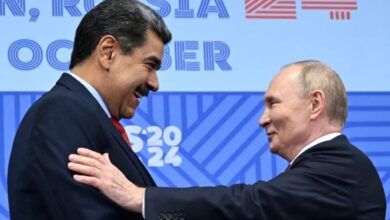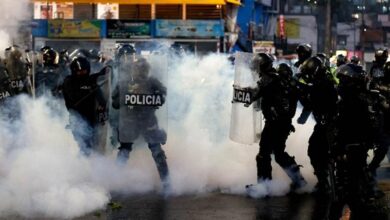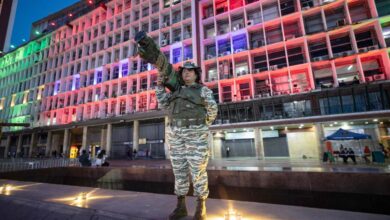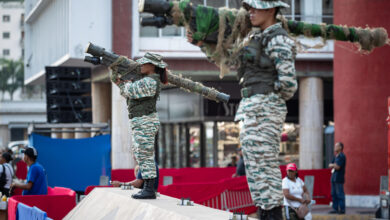How is the War Russia and Ukraine Similar to the Conflict Between Israel and Palestine?
In LatinAmerican Post, we examine two main points of comparison between the Russia-Ukraine war and the Israel-Palestine conflict.

Photo: AFP, Wikimedia
LatinAmerican Post | Christopher Ramírez Hernández
Listen to this article
Leer en español: ¿En qué se parece la guerra de Rusia y Ucrania con el conflicto entre Israel y Palestina?
Israel is conducting a large-scale military operation in the West Bank called "Mission House and Garden." With an air and ground assault on the Jenin refugee camp (one of the most important in the area), this operation, which began on 3 July and ended on the night of Tuesday, 4 July, was the most intense in the region since the end of the second intifada in 2005.
Over 1,000 troops were deployed, including drone bombing in the north, in an operation that Israeli Prime Minister Benjamin Netanyahu says "until the established objectives are reached."
Read also: The Violent Protests in France are Not Because of their Migratory Present
According to the Israeli army's international spokesman, Richard Hecht, the operation aimed to disrupt terrorist attacks against Israeli targets and concentrated on the city of Jenin without expanding to other areas of the West Bank. In this regard, several Israeli officials emphasized that the campaign is not aimed at the Palestinian Authority and does not seek to occupy the territory.
At the same time as the Israeli attack on what they consider "a disputed area" in the West Bank, many Russian troops were deployed in Ukraine. "More than 180,000 (Russian soldiers) were deployed in the area of responsibility (of the Eastern Group of Forces)," said Serhii Cherevatyi, spokesman for the Eastern Group of the Armed Forces of Ukraine.
This war, which has been going on for more than 16 months, left 180,000 Russian soldiers dead in February this year, compared to 100,000 on the Ukrainian side, according to information compiled by Norwegian authorities.
Israel as Russia and Palestine as Ukraine?
Of course, when two events of this caliber coincide amid human history, it is not uncommon for comparisons to begin to be drawn between the characters involved in these conflicts, with supporters of one side or the other wanting to portray themselves as the "good guys" in the story.
For this reason, it is difficult to discuss whether there are similarities or differences in the intentions present in the war in Ukraine and the geopolitical mess between Israel and the Palestinian state. What we can talk about, however, is implicit situations arising from international organizations' definitions that are partly unrelated to these situations.
1. Armed Conflicts
According to the definition of International Humanitarian Law (IHL), cited by Amnesty International, an armed conflict "is a violent confrontation between two sides or large groups of people which results in death and material destruction." In this sense, the events on Asian soil and the war in Ukraine are broadly considered armed conflicts and share more similarities than differences.
IHL establishes that an armed conflict can be international or non-international, based on the participants in the conflict, which in the case of the conflicts above, have scenarios that allow them to be positioned in both spectrums.
In the case of the war in Ukraine, the international armed conflict is made clear by the simple fact that it is a war between two sovereign states over the control of a territory.
The same is true between Israel and Palestine, even though both states are not considered as such by some enemy factions or their respective allies. However, with The recognition of Palestine as a non-member observer State of the UN in 2012 , the international organization gave rise to the first recognition of the Palestinian state as such, so that the belligerent clashes between Israelis and Palestinians can be considered in various political scenarios as an international armed conflict.
However, non-international armed conflict is also a scenario in both cases. For example, in the Ukrainian war, it is also clear that illegal pro-Russian armed groups were involved in battles against the Ukrainian Armed Forces in the Dombash region, in an extension of the Dombash War between 2014 and 2022.
The same situation exists between Hamas, an organization considered terrorist by the US, and Fatah, considered by many to be the armed proxy of the Palestinian state itself. While the former opposes negotiations with Israel and does not recognize its existence, the latter advocates peace regardless of the cost. In 2006, Hamas came to power in the Gaza Strip through elections, which triggered conflict with Fatah, plunging the Palestinian territories into civil war.
2. Disputed Territories
Another similarity in both conflicts is the political situation of the disputed territories. In the first place we have the Gaza Strip and the West Bank, considered by the Palestinians as their territory, while international law and the UN see them as "occupied territory" without any owner but with a solid Israeli presence as a "military conqueror." Israel, for its part, sees them as "disputed territory," giving Palestine the title of "possible conqueror" as well.
On the other hand, the war in Ukraine has a similar dilemma with the Dombas region, specifically with the cities of Donetsk and Luhansk, which 2014 proclaimed themselves People's Republics in apparent defiance of Ukrainian sovereignty over them. Thus, this region suffers the same fate as Gaza and the West Bank in Asia: it is considered by Russia as an annexation of its territory since the beginning of the war, while Ukraine, the UN, NATO, and the European Union still consider it to be Ukrainian territory "invaded by the Kremlin (Russian government)."
In short, the technical similarities between the Ukrainian war and the Israeli-Palestinian conflict outweigh their differences on the basis that both have military forces fighting over territories that are "everybody's and nobody's"; with the help of armed groups that are illegal for some and licit for others; and with strong nationalist sentiment on the battlefield.





